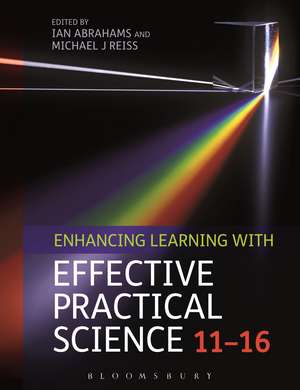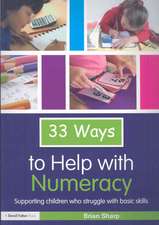Enhancing Learning with Effective Practical Science 11-16
Editat de Dr Ian Abrahams, Professor Michael J. Reissen Limba Engleză Paperback – 14 dec 2016
Preț: 201.74 lei
Preț vechi: 245.87 lei
-18% Nou
Puncte Express: 303
Preț estimativ în valută:
38.64€ • 39.81$ • 32.37£
38.64€ • 39.81$ • 32.37£
Carte tipărită la comandă
Livrare economică 24 februarie-10 martie
Preluare comenzi: 021 569.72.76
Specificații
ISBN-13: 9781472592279
ISBN-10: 1472592271
Pagini: 280
Ilustrații: 56 bw illus
Dimensiuni: 189 x 246 x 21 mm
Greutate: 0.54 kg
Editura: Bloomsbury Publishing
Colecția Bloomsbury Academic
Locul publicării:London, United Kingdom
ISBN-10: 1472592271
Pagini: 280
Ilustrații: 56 bw illus
Dimensiuni: 189 x 246 x 21 mm
Greutate: 0.54 kg
Editura: Bloomsbury Publishing
Colecția Bloomsbury Academic
Locul publicării:London, United Kingdom
Caracteristici
Edited by two leading experts, drawing on their own knowledge and experience as well as on that of experienced teachers and other leading members of the science education research community
Notă biografică
Ian Abrahams is Professor of Science Education at the University of Lincoln, UK.Michael J. Reiss is Professor of Science Education at IOE, UCL's Faculty of Education and Society, University College London, UK.
Cuprins
How to Use this Book, Ian Abrahams and Michael J. Reiss 1. The Role of Practical Work in Science Education, Ian Abrahams and Michael J. Reiss 2. Effective Practical Work: 'Hands-on' and 'Minds-on', Ian Abrahams and Michael J. Reiss 3. Biology: Session Guides 11-14, Indira Banner and Mark Winterbottom 4. Biology: Session Guides 15-16, Indira Banner and Mark Winterbottom 5. Chemistry: Session Guides 11-14, Ann Childs and Elaine Wilson 6. Chemistry: Session Guides 15-16, Ann Childs and Elaine Wilson 7. Physics: Session Guides 11-14, James de Winter and Michael Inglis 8. Physics: Session Guides 15-16, James de Winter and Michael Inglis 9. Additional Effective Practical Work, Ian Abrahams and Michael J. Reiss 10. Conclusions, Ian Abrahams and Michael J. ReissReferences Index
Recenzii
With its clear structure and concise chapters, this book should be within reach of every science teacher in my view. No matter how many years you have been teaching science, this book really is one of the best practical resources I have come across ... It is a valuable resource that can be used time and again in the classroom.
This book is both timely and useful . [and] had a positive effect on my practice and the learning of my students.
This guide to making practical science more effective, in order to enhance the learning experience, will be welcomed by both new and established science teachers and should feature in the libraries of all teacher-training institutions.
This book demonstrates the value of using education research to inform the practice of science teaching in schools. It presents a thoughtful and accessible approach to improving the effectiveness of practical work in the science classroom.
This practical manual is really useful as it guides the science practical practitioner. Furthermore, it is grounded by the age-old debate about the added value of doing practical work in science lessons. The effectiveness matrix enables the teacher to plan the teaching and learning that will promote learning and understanding of the science. The Secretary for State for Education wants evidence-based practice: this book delivers on that front too!
This book provides a large collection of practical activities for secondary science, many familiar to teachers, some less so. The distinctive feature of this book is its use of the 2x2 'effectiveness matrix' ... Abrahams and Reiss acknowledge that the effectiveness of a practical activity is not determined by the activity itself but by how it is implemented in the classroom. Their book provides a framework that can help teachers to implement practical science activities more thoughtfully, so that more of their students succeed in doing and learning what is intended.
The teaching of science in schools and universities rests on a blind faith in the value of 'practical work'. This book takes a close look at the evidence to show that there is far too much 'hands on' and not enough 'minds on'. Building on an extensive program of research, it shows how to make practical work a more effective learning experience offering 72 examples. In doing so, it injects a much needed breath of fresh air questioning many long held myths about practical work. It should be compulsory reading for every practising teacher of science.
Practical work has long been a core feature of science lessons in the secondary school, yet there is much evidence from research that school practicals are often ineffective at helping students learn the key concepts that the laboratory or fieldwork is meant to introduce or illustrate. Despite this, science teachers are generally committed to practical work, and with good reason. The very essence of science - as something distinct from philosophy on the one hand and craftwork on the other - is the interplay between theory and systematically examined empirical evidence. An authentic science education gives learners experience of this back-and-forth between ideas and experience, and yet it is just this interplay that often gets missed when students engage in practical work. Michael Reiss and Ian Abrahams have here put together a resource for classroom teachers that will support effective practical work in the secondary school. Drawing upon both research and the expertise of biology, chemistry and physics education specialists, this book sets out the core principles behind effective science practical work, and exemplifies these with a wide range of examples of practicals suitable for 'minds-on' (as well as hands-on) student activities. This book is likely to prove insightful and invaluable to all teachers of secondary science.
This book is both timely and useful . [and] had a positive effect on my practice and the learning of my students.
This guide to making practical science more effective, in order to enhance the learning experience, will be welcomed by both new and established science teachers and should feature in the libraries of all teacher-training institutions.
This book demonstrates the value of using education research to inform the practice of science teaching in schools. It presents a thoughtful and accessible approach to improving the effectiveness of practical work in the science classroom.
This practical manual is really useful as it guides the science practical practitioner. Furthermore, it is grounded by the age-old debate about the added value of doing practical work in science lessons. The effectiveness matrix enables the teacher to plan the teaching and learning that will promote learning and understanding of the science. The Secretary for State for Education wants evidence-based practice: this book delivers on that front too!
This book provides a large collection of practical activities for secondary science, many familiar to teachers, some less so. The distinctive feature of this book is its use of the 2x2 'effectiveness matrix' ... Abrahams and Reiss acknowledge that the effectiveness of a practical activity is not determined by the activity itself but by how it is implemented in the classroom. Their book provides a framework that can help teachers to implement practical science activities more thoughtfully, so that more of their students succeed in doing and learning what is intended.
The teaching of science in schools and universities rests on a blind faith in the value of 'practical work'. This book takes a close look at the evidence to show that there is far too much 'hands on' and not enough 'minds on'. Building on an extensive program of research, it shows how to make practical work a more effective learning experience offering 72 examples. In doing so, it injects a much needed breath of fresh air questioning many long held myths about practical work. It should be compulsory reading for every practising teacher of science.
Practical work has long been a core feature of science lessons in the secondary school, yet there is much evidence from research that school practicals are often ineffective at helping students learn the key concepts that the laboratory or fieldwork is meant to introduce or illustrate. Despite this, science teachers are generally committed to practical work, and with good reason. The very essence of science - as something distinct from philosophy on the one hand and craftwork on the other - is the interplay between theory and systematically examined empirical evidence. An authentic science education gives learners experience of this back-and-forth between ideas and experience, and yet it is just this interplay that often gets missed when students engage in practical work. Michael Reiss and Ian Abrahams have here put together a resource for classroom teachers that will support effective practical work in the secondary school. Drawing upon both research and the expertise of biology, chemistry and physics education specialists, this book sets out the core principles behind effective science practical work, and exemplifies these with a wide range of examples of practicals suitable for 'minds-on' (as well as hands-on) student activities. This book is likely to prove insightful and invaluable to all teachers of secondary science.













